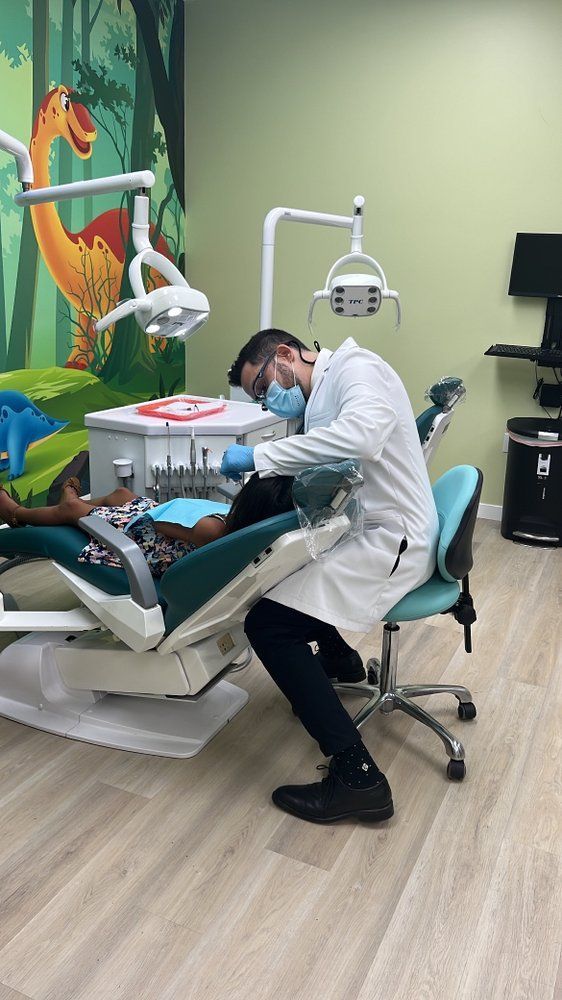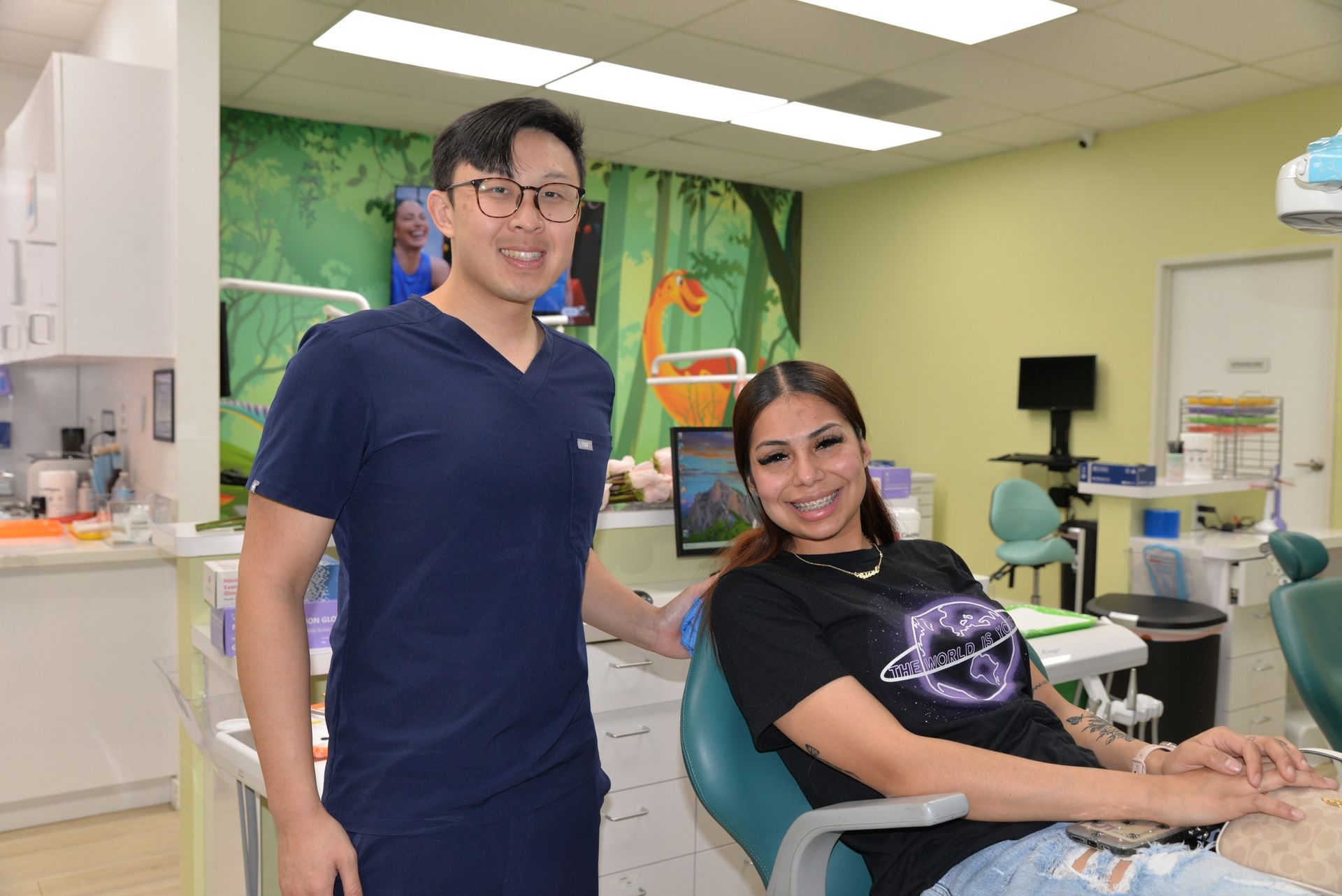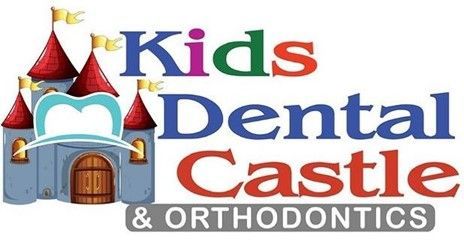Orthodontics:
We understand the importance of a healthy and confident smile. Our orthodontic services help correct misaligned teeth and jaws, improving aesthetics and functionality. With advanced technology and personalized treatment plans, our orthodontists create beautiful smiles that can boost your child's self-esteem and overall oral health.
Orthodontics Treatment for Children
When to get the first orthodontic check-up for your child?
Although many orthodontic problems are best treated in late childhood, some conditions are best dealt with at an earlier age. By age 7, most children have a mix of baby (primary) and adult (permanent) teeth. Some common orthodontic problems seen in children can be traced to genetics, i.e., inherited from their parents. Children may experience dental crowding, too much space between teeth, protruding teeth, extra or missing teeth, and sometimes jaw growth problems.
Other malocclusions (literally, “bad bites”) are acquired. In other words, they develop over time. They can be caused by thumb or finger-sucking, mouth breathing, dental disease, abnormal swallowing, poor dental hygiene, the early or late loss of baby teeth, accidents, or poor nutrition. Trauma and other medical conditions, such as birth defects, may contribute to orthodontic problems as well. Sometimes an inherited malocclusion is complicated by an acquired problem. Whatever the cause, the orthodontist is usually able to treat most conditions successfully.
Orthodontists are trained to spot subtle problems with jaw growth and emerging teeth while some baby teeth are still present. The advantage of early detection of orthodontic problems is that some problems may be easier to correct if they are found and treated early. Waiting until all the permanent teeth have come in, or until facial growth is nearly complete, may make correction of some problems more difficult. For these reasons, the AAO recommends that all children get a check-up with an orthodontist no later than age 7. While your child’s teeth may appear straight to you, there could be a problem that only an orthodontist can detect. Of course, the check-up may reveal that your child’s bite is fine, and that is comforting news.
Waiting for the right time to start orthodontic treatment
Even if a problem is detected, chances are we will take a “wait-and-see” approach, checking your child from time to time as the permanent teeth come in and the jaws and face continue to grow. For each patient who needs treatment, there is an ideal time for it to begin in order to achieve the best results. Starting earlier doesn’t necessarily mean finishing sooner. The orthodontist has the expertise to determine when the treatment time is right. The orthodontist’s goal is to provide each patient with the most appropriate treatment at the most appropriate time.
In some cases, your orthodontist might find a problem that can benefit from early treatment. Early treatment may prevent more serious problems from developing and may make treatment at a later age shorter and less complicated. For those patients who have clear indications for early orthodontic intervention, early treatment gives your orthodontist a chance to:
- Guide jaw growth
- Lower the risk of trauma to protruded front teeth
- Correct harmful oral habits
- Improve appearance and self-esteem
- Guide permanent teeth into a more favorable position
- Improve the way lips meet
It’s not always easy for parents to tell if their child has an orthodontic problem. Here are some signs or habits that may indicate the need for an orthodontic examination:
Early or late loss of baby teeth
Difficulty in chewing or biting
Mouth breathing
Thumb sucking
Finger sucking
Crowding, misplaced, or blocked-out teeth
Jaws that shift or make sounds
Biting the cheek or roof of the mouth
Teeth that meet abnormally or not at all
Jaws and teeth that are out of proportion to the rest of the face
If any of these problems are noted by parents, regardless of age, it is advisable to consult an orthodontist. It is not necessary to wait until age 7 for an orthodontic check-up.

Orthodontics treatment for Teens
Most patients begin orthodontic treatment between ages 9 and 16, but this varies depending on the individual. Because teenagers are still growing, the teen years are often the optimal time to correct orthodontic problems and achieve excellent results.
Most orthodontic problems are inherited. Examples of these genetic problems are crowding, too much space between teeth, protruding upper teeth, extra or missing teeth, and some jaw growth problems.
Other malocclusions (crooked teeth) are acquired. In other words, they develop over time. They can be caused by thumb-sucking or finger-sucking as a child, mouth breathing, dental disease, abnormal swallowing, poor dental hygiene, the early or late loss of baby (primary) teeth, accidents, poor nutrition, or certain medical problems.
Sometimes an inherited malocclusion is complicated by an acquired problem. But whatever the cause, the orthodontist is usually able to treat these conditions successfully.
Treatment is important because crooked or crowded teeth are hard to clean, and that may contribute to tooth decay, gum disease, and tooth loss. A bad bite can also cause abnormal wear of tooth surfaces, difficulty in chewing or speaking, excess stress on supporting bone and gum tissue, and possible jaw joint problems. Without treatment, these problems may become worse. Orthodontic treatment to correct a problem may prove less costly than the additional dental care required to treat the problems that can develop in later years.
In addition, there is an emotional toll that comes from hiding your smile. When you are not confident in the way you look, your self-esteem suffers. Teens whose malocclusions are left untreated may go through life feeling self-conscious, hiding their smiles with tight lips or a protective hand. This can quickly be remedied with orthodontic care.
Orthodontics treatment for Adults
It is well-recognized that when left untreated, many orthodontic problems will worsen. When you have a malocclusion (“bad bite”), your teeth may be crowded, excessively spaced, or may not fit together correctly. Such conditions may lead to dental health problems. Crowded teeth are hard to clean and, given time, may contribute to tooth decay, gum disease, and even tooth loss. Bad bites can also result in abnormal wearing of tooth surfaces, difficulty chewing, and damage to supporting bone and gum tissue. Poorly aligned teeth can contribute to pain in the jaw joints.
You’ll be pleased to learn that orthodontic treatment will fit in with your current lifestyle; you can sing, play a musical instrument, dine out, kiss, and even have your picture taken without hesitation. In fact, one in five orthodontic patients today is an adult. The American Association of Orthodontists estimates that more than 1,000,000 adults in the United States and Canada are receiving treatment from their member orthodontists.
It is worth noting that the rate of tooth loss has declined over recent decades. Our great-grandparents, for the most part, lost their teeth around age 40. Today’s 25-year-old have the potential to keep and use their teeth for another 75 years. This signifies a major shift in dental health care and life expectancy. Because teeth that do not fit well often wear down more quickly, it is important to make sure that your teeth are in good alignment and well maintained in your adult years.

Braces
Braces are the tried-and-true orthodontic treatment method, and we achieve great results for our patients with them! Modern braces are even more accurate and efficient than their predecessors and are a great treatment option for every age.
How do braces work?
Fixed braces work using a series of brackets, metal archwires, and small elastics. We will affix a bracket to the front of each of your teeth and run the archwire through them. The elastics are what hold it all in place.
You will visit our office for regularly scheduled adjustment appointments over the course of treatment. Dr. Tran will make small adjustments to your archwires so that gentle pressure is applied to targeted areas. This will slowly move your teeth into alignment!
Types of braces we offer
- Metal braces: Metal braces are the traditional orthodontic treatment. They are great for all ages, and you can customize the color of your elastics to make treatment more fun!
- Clear braces: Clear braces provide an aesthetic finish for your traditional treatment. Made from tooth-colored ceramic, clear braces help your treatment blend in naturally with your smile.
- Invisible braces: Invisible braces, also known as Invisalign® clear aligners, don’t use the traditional bracket system. Instead, they shape your smile with barely-there custom trays for a truly discreet treatment.
Benefits of fixed braces
- Effective: Braces have been around for years for a reason, and new technology has only served to perfect this trusted treatment. Braces can be used to treat even the most complex orthodontic issues.
- Discreet: Fixed braces come in a clear option, which can help the treatment blend in with the color of your smile. Brackets are also smaller and lower-profile than ever before.
- Durable: As long as you follow the dietary guidelines laid out by Dr. Junyi, your braces should last you through your treatment from start to finish.
- Affordable: Especially when coupled with our flexible payment plans, fixed braces are a budget-friendly option for straightening your smile.
Sports dentistry involves the prevention and treatment of dental injuries and related oral diseases, as well as the sharing of information and equipment designed to help protect the teeth, mouth, jaw, and face of athletes of all ages. Injuries to the teeth and mouth are common among athletes. It’s important to protect your child’s smile if he or she plays sports for aesthetic as well as health reasons.
Tooth Knocked Out
Time is the most important factor when trying to save a tooth, so get to our office as soon as possible. In general, there is a 30-minute window of opportunity to re-implant a permanent tooth in the socket.
Do not try to re-implant the tooth yourself.
The best liquid to transport a tooth in is cold milk. If milk is not available, use saliva (if possible), saline, or, if nothing else is available, water.
Don’t let the tooth dry out, and don’t wrap it in anything.
Don’t touch the tooth root if you can avoid it.
Tooth Chipped/ Cracked
We will likely use an X-ray of the tooth to determine the treatment necessary.
For a serious chip that exposes the pulp of the tooth, get to our office as soon as possible.
If a tooth is chipped or cracked, sometimes it can be fixed with a filling or bonding alone.
Sometimes a tooth is cracked or chipped in a way that affects the nerve of the tooth, and a more complicated treatment may be needed.
Tooth Displaced or Avulsed
If a tooth is displaced or avulsed due to trauma, see us as soon as possible.
Do not try to move the tooth back on your own.
For any mouth discomfort, before you get to our office, apply ice.
Preventing Injury
One of the best ways to prevent injury to your child’s teeth and mouth is to have him or her wear a mouthguard while playing sports. There are several types of mouthguards to choose from, and we can help you choose the best one for your athlete’s particular needs.
Orthodontic Emergency
Call our office as soon as possible if you break or loosen any of your appliances. Please do not come directly to the office – by calling us, you will allow us to create a time to see you. Even if you have a regular appointment scheduled, call us immediately to notify us if you need an appliance repaired.
Loose Brackets or Bands:
Call our office immediately for advice if a bracket or wire is loosened. The bracket may need to be re-fitted as soon as possible. You may have a situation that requires cutting a wire or sliding a bracket off a wire at night or over the weekend. If you need to cut a wire in case of emergency, you may use fingernail clippers that have been washed and sterilized in alcohol. Please call our office the next business day so that we may schedule an appointment for you.
Wire Irritations:
Sometimes discomfort caused by a wire on your braces can be resolved by moving the wire away from the irritated area with a cotton swab or eraser. If the wire does not move, try covering the end of it with a small piece of cotton or a small amount of wax. If the wire is painful, you can cut it with nail clippers or scissors that have been washed and sterilized in alcohol. If you cannot resolve the wire irritation, call our office for an appointment.
Lost Separators:
Most patients lose a separator during their treatment. Do not worry about losing a separator, but call our office to see if it needs to be replaced.
Discomfort with Orthodontic Treatment:
During the first week, after your braces are in place and routine adjustments are complete, you will likely feel some pain, soreness, or discomfort. You may take acetaminophen or other non-aspirin pain relievers while you adjust to your new braces. A warm washcloth or heating pad may reduce the soreness in your jaws.
Foods to Avoid
For most situations, common sense will tell you what to avoid. Hard foods, sticky foods, and foods high in sugar must be avoided. Hard foods can break or damage wires and brackets. Sticky foods can get caught between brackets and wires. Minimize sugary foods; they cause tooth decay and related problems. Nail biting, pencil and pen chewing, and chewing on foreign objects should be avoided.
Examples of Sticky Foods to Avoid:
- Gum (sugar-free or regular)
- Licorice
- Sugar Daddies
- Toffee
- Tootsie Rolls
- Caramels
- Starburst
Examples of Hard Foods to Avoid:
- Ice
- Nuts
- Hard taco shells
- French bread crust/rolls
- Corn on the cob
- Apples and carrots (unless cut into small pieces)
- Bagels
- Chips
- Jolly Ranchers
- Pizza crust
- Uncooked carrots (unless cut)
Minimize Sugary Foods like:
- Cake
- Ice Cream
- Cookies
- Pie
- Candy
- Sugary beverages
- Carbonated beverages
- It’s important to regularly check your braces for bent or loose wires and brackets. In the event of a loose/broken wire or bracket, call our office immediately to arrange an appointment for repair.
